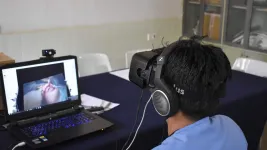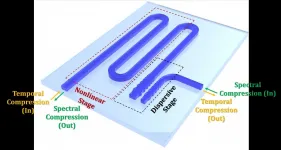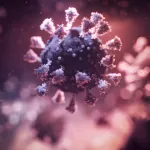(Press-News.org) Cleft lip and palate is one of the most common congenital malformations. Its causes are mainly genetic. However, it is still largely unknown exactly which genes are affected. A new international study led by the University of Bonn now provides new insights. The results are published in the journal Human Genetics and Genomics Advances, but are already available online.
The researchers from the Institute of Human Genetics at the University Hospital Bonn combined various data sources in their work. In the course of their research, they discovered five new regions in the human genome in which variations in the DNA sequence are associated with an increased risk of malformation. A total of 45 such risk regions are now known. For some of them, the researchers were also able to show which genes are affected by these changes. "Our results provide new insights into the development of the disease, but also into the development of the face in the early embryo as a whole," explains Dr. Kerstin Ludwig.
Ludwig leads an Emmy Noether junior research group at the Institute of Human Genetics at the University Hospital Bonn, which focuses on the genetic causes of cleft lip and palate. The average contribution of genes to this frequent malformation is estimated at more than 90 percent. "The genetic contribution is complex," Ludwig says. "That means there is not just one gene, but a whole set of genes that contribute to the malformation."
Data from previously published genomic studies combined
The blueprint of each individual human being is stored in his or her DNA, a kind of giant lexicon with around three billion letters. People are different, and the contents of their DNA lexicon differ accordingly. However, for people with a cleft lip and palate, at least the passages that have something to do with the disease should be similar. Science makes use of this basic assumption: By comparing the DNA of many thousands of affected individuals at several million sites, researchers can identify genetic regions that result in a higher risk of disease.
A whole series of such "genome-wide association studies" (GWAS) have been published in recent years. "We have now combined data from previously published GWAS," explains Dr. Julia Welzenbach, a postdoctoral researcher in Ludwig's group who led the study that has now been published. This makes it possible to find even those changes in DNA that only slightly increase the risk for the malformation and are therefore overlooked in individual studies. "In this way we identified five risk regions that were previously unknown," Welzenbach says.
However, this does not automatically contribute to a better understanding of the disease: Only about two percent of DNA actually contains genetic information in the sense of direct instructions for building proteins. Science is just beginning to understand what the remaining 98 percent is for. "The 45 risk regions we know about today are all within that 98 percent, which we also call non-coding regions," Welzenbach explains.
It is now known that part of the non-coding DNA serves to regulate the activity of genes. Some of these DNA regions ensure, for example, that a certain gene is read more frequently or in certain tissues. Such regulatory regions are therefore also called enhancers. Others, however, act as silencers - they switch off certain genes.
Mutations affect regulatory DNA elements
In each cell, only certain genes are active at a given time of development. In other words, there is a cell type- and time-specific pattern of gene activity, and the silencers and enhancers are partly responsible for this. "Some regulatory DNA sequences are now known to act as silencers or enhancers during early facial development of the embryo," Ludwig says. "We were able to show for some of the genetic changes from the GWAS data that they affect these regulatory sequences, and therefore also show which genes increase or decrease in activity as a result."
Presumably, each of the 45 risk regions known today alters the effect of an enhancer or silencer. In this way, they disrupt the finely balanced activity pattern of genes that play a role in error-free facial development. And it is this disruption, combined with additional factors, that increase an individual's risk to get a cleft lip and palate.
INFORMATION:
Participating institutions and funding:
In addition to Bonn University Hospital, the study involved the Universities of Manchester, Cologne, Pittsburgh, Connecticut as well as Johns Hopkins University in Baltimore, Emory University in Atlanta and the University of Cantabria. It was funded by the German Research Foundation (DFG, LU 1944-3/1).
Publication: Julia Welzenbach, Nigel L. Hammond, Miloš Nikoli?, Frederic Thieme, Nina Ishorst, Elizabeth J. Leslie, Seth M. Weinberg, Terri H. Beaty, Mary L. Marazita, Elisabeth Mangold, Michael Knapp, Justin Cotney, Alvaro Rada-Iglesias, Michael J. Dixon and Kerstin U. Ludwig: Integrative approaches generate insights into the architecture of non-syndromic cleft lip with or without cleft palate. Human Genetics and Genomics Advances, DOI: https://doi.org/10.1016/j.xhgg.2021.100038
Contact:
Dr. Kerstin U. Ludwig
Emmy-Noether Gruppenleiterin
Institut für Humangenetik
Universitätsklinikum Bonn
Tel. +49-228-6885420
E-Mail: kerstin.ludwig@uni-bonn.de
Dr. Julia Welzenbach
Institut für Humangenetik
Universitätsklinikum Bonn
Tel. +49-228-6885435
E-Mail: jwel@uni-bonn.de
A new report that could help improve how immersive technologies such as Virtual Reality (VR) and Augmented Reality (AR) are used in healthcare education and training has been published with significant input from the University of Huddersfield.
Professor David Peebles, Director of the University's Centre for Cognition and Neuroscience, and Huddersfield PhD graduate Matthew Pears contributed to the report - 'Immersive technologies in healthcare training and education: Three principles for progress' - recently published by the University of Leeds with input from range of academics, technologists and health professionals.
The principles have also been expanded upon in a letter to the prestigious journal BMJ ...
A train carrying cargo has finite space. The amount of cargo that can be carried onboard is limited by the size of the cargo and the capacity of the train. Analogously, the amount of time taken up by an optical signal limits the amount of data that can be carried. Temporally shorter signals allow more data to be squeezed into a given time duration, in a method called optical time division multiplexing. Photonics researchers have recently succeeded in squeezing light in time by 11 times. The developed temporal compression system allows an equivalent increase in the number of bits transmitted by light ...
A new international study has found that the key properties of the spikes of SARS-CoV-2 virus which causes COVID-19 are consistent with those of several laboratory-developed protein spikes, designed to mimic the infectious virus.
A central component in designing serological tests and vaccines to protect against COVID-19 is the manufacture of protein "spikes". These recombinant spikes closely mimic those sticking out of surface of the infectious virus and trigger the body's immune system into action.
Laboratory manufactured spikes are also used for serological testing (also referred to as antibody testing) and as research reagents. The findings show how that viral spike manufactured through different methods in laboratories across the globe ...
Since July 2020, remdesivir has been conditionally approved in Europe for the treatment of coronavirus disease (COVID-19) in adults and adolescents aged 12 years and older with pneumonia who require supplemental oxygen but no invasive ventilation. In an early benefit assessment, the German Institute for Quality and Efficiency in Health Care (IQWiG) has now investigated whether the drug, which was originally developed for the treatment of Ebola virus disease, offers these patients an added benefit compared to the appropriate comparator therapy (here: therapy according to physician's choice).
This investigation yielded an indication of a considerable added benefit of remdesivir compared to the appropriate comparator therapy for adults with pneumonia ...
In a study published in Physical Review Letters, academician GUO Guangcan's team from University of Science and Technology of China of the Chinese Academy of Sciences made progress in the open quantum system research. This team, collaborating with Austrian theoretical physicist Philip Taranto, demonstrated the non-Markovianity in the multi-step evolution of the open quantum system, and proved the measurement-dependent property of quantum memory effects.
In quantum information science, it is crucial to understand and control the memory effects for the development of quantum technology. For the coupling of the system and environment, the evolution of open quantum system presents the non-Markovianity, ...
Faba beans have been an excellent source of food protein since pre-historic times, but about 5% of people, mostly from regions where malaria has been endemic and who carry a certain mutation, can't eat them. Now, an international team of researchers, led by the Universities of Helsinki and Copenhagen as well as Luke Natural Resources Institute Finland, has identified the gene responsible for the production of vicine and convicine, which are harmful to these people. In the work published in Nature Plants, the team reports that the VC1 gene plays a central role in the biosynthesis these compounds.
Faba beans - Pythagoras and his followers avoided them and Roman priests of Jupiter associated them with death. ...
A research team led by Prof. CHEN Xianhui from University of Science and Technology of China of the Chinese Academy of Sciences (CAS) found an unusual competition between charge density wave (CDW) and superconductivity in CsV3Sb5, a layered kagome metal, which provides key experimental evidence for understanding novel CDW and superconductivity. The result was published on Nature Communications and recommended as featured article.
Traditional superconductivity and CDW are two different electronic states, which both originate from electron phonon coupling and Fermi instability. In the conventional coexistence image of CDW and superconductor, after entering the CDW state, the energy gap is opened due to the nesting of Fermi surface, resulting in the loss of density ...
The stage is set for a new carbon storage economy to emerge along the Gulf Coast, according to a study led by The University of Texas at Austin, with the region offering ample opportunities to capture and store carbon, and recent state and federal incentives giving an added push to get started.
Carbon capture and storage, or CCS, is a technology that keeps CO2 out of the atmosphere by capturing emissions and storing them deep underground. It can help fight climate change by lowering industrial emissions now while renewable energy sources are being developed, said Tip Meckel, a senior research scientist at the Gulf Coast Carbon Center, a research group at the UT Bureau ...
Since the discovery of the first fossil remains in the 19th century, the image of the Neanderthal has been one of a primitive hominin. People have known for a long time that Neanderthals were able to effectively fashion tools and weapons. But could they also make ornaments, jewellery or even art? A research team led by the University of Göttingen and the Lower Saxony State Office for Heritage has analysed a new find from the Unicorn Cave (Einhornhöhle) in the Harz Mountains. The researchers conclude that, in fact, Neanderthals, genetically the closest relative to modern humans, had remarkable cognitive abilities. The results of the study were published in Nature Ecology and Evolution.
Working with the Unicornu Fossile society, the scientists ...
Human activities like the burning of coal and fossil fuels have caused CO2 to accumulate in the atmosphere, which has significantly affected the Earth's climate. As a result, several scientists are looking for ways to convert CO2 into other valuable organic products, such as 1-butanol, which has shown promise as an alternative fuel for vehicles. This could help reduce our dependence on fossil fuels.
One method of obtaining useful compounds is by the electrochemical reduction reaction (CO2RR). Researchers have developed metal-based catalysts that can fulfill this task. However, there is a caveat: most of these catalysts are expensive and produce a variety of products during the reaction, ...







